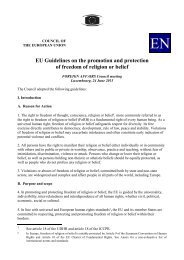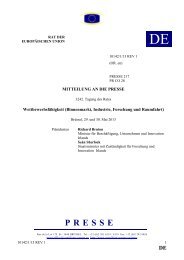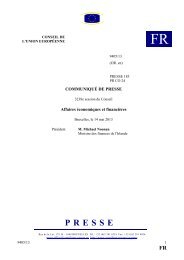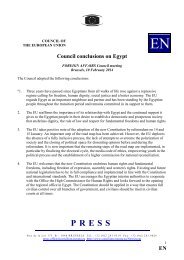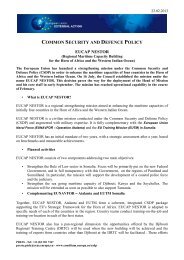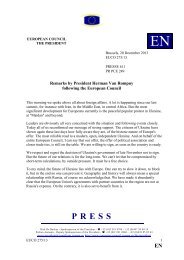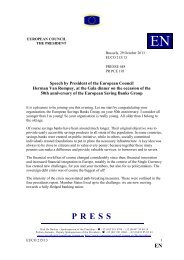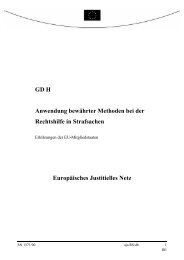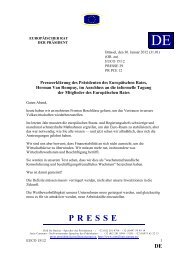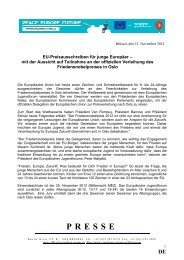14508/09 ADD 1 PL/vk 1 DG G COUNCIL OF THE ... - Europa
14508/09 ADD 1 PL/vk 1 DG G COUNCIL OF THE ... - Europa
14508/09 ADD 1 PL/vk 1 DG G COUNCIL OF THE ... - Europa
You also want an ePaper? Increase the reach of your titles
YUMPU automatically turns print PDFs into web optimized ePapers that Google loves.
have not made payments to pension schemes. But there is probably a difference in many countries<br />
between younger and older pensioners and it should also be mentioned that this indicator does not<br />
take into consideration assets in terms of savings and property for example, or for that matter debts,<br />
which can be assumed to be inequitably distributed between women and men, but also differ<br />
between countries depending on the pension system.<br />
Indicator 2: One way of investigating the risk of poverty for women is to compare single women<br />
with single men, then questions are avoided of how resources in the household are distributed and<br />
how women’s decision-making power and well-being are affected by not having their own<br />
earnings.. Being single means a higher risk for poverty than being married/cohabiting for both<br />
women and men. In Latvia for example, more than half of the single women and men are at-risk-of-<br />
poverty. In most countries the risk of poverty is higher for single women than for single men, but in<br />
Poland, Hungary and Luxembourg the situation is the reverse, and in Sweden, Finland, France and<br />
Denmark the risk is more or less the same for the two sexes (see figure 4.1.1).<br />
Single parents are besides elderly women a category, which is often mentioned as facing a<br />
particular risk of suffering from poverty. The number of single parents is rising across most of the<br />
EU. In all countries the majority of single parents are women, accounting for 80 to 95 % of all lone<br />
parents in most countries (Fagan et al. 2006 p. 11). The main entry route into lone parenthood is<br />
relationship breakdown for married or cohabiting couples; sole parenting (single women who<br />
become mothers without marrying or cohabiting) is much less common. Lone-parent households<br />
are susceptible to poverty for several reasons. There are extra economic disadvantages and work-<br />
family reconciliation pressures when raising children alone compared with the resources available<br />
in dual-parent households. The pressures of being the single breadwinner are compounded for<br />
women because the wages they can obtain in the labour market are lower on average than those of<br />
men.<br />
When we compare women aged 65 years and older (of whom some are married/cohabiting), and<br />
single parents (of whom a majority are women), we find that the risk of poverty is considerably<br />
greater for single parents (and their children) in most countries with the exception of Denmark,<br />
Finland, Latvia and especially Cyprus (see figure 4.1.2).<br />
<strong>14508</strong>/<strong>09</strong> <strong>ADD</strong> 1 <strong>PL</strong>/<strong>vk</strong> 53<br />
ANNEX <strong>DG</strong> G EN



